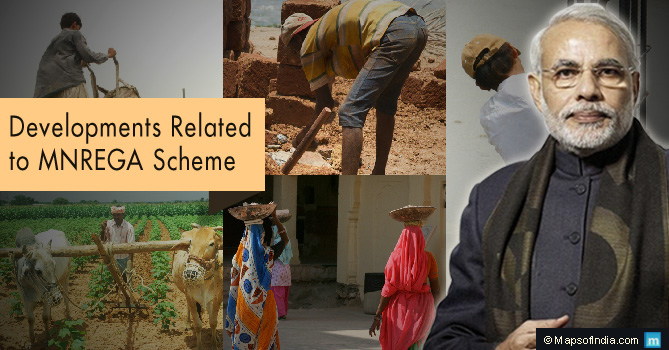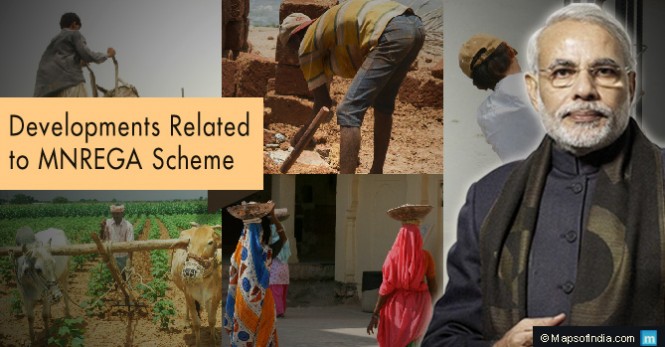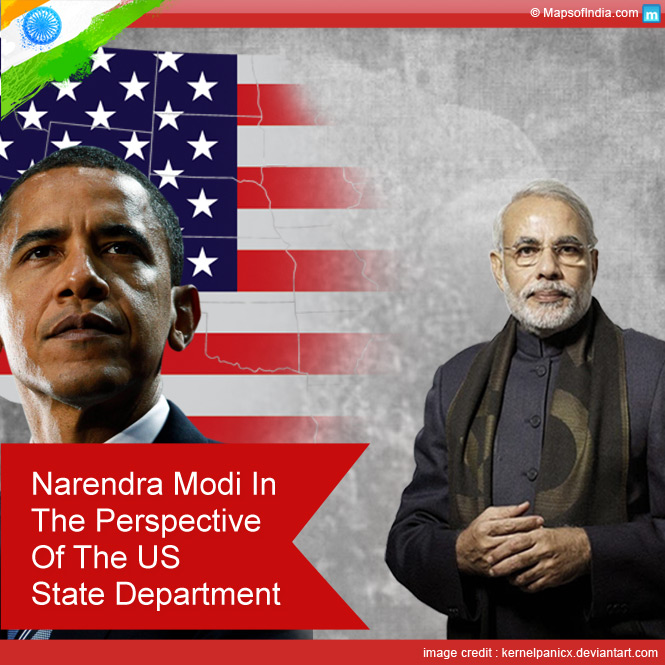What is Mahatma Gandhi National Rural Employment Guarantee Act?
The National Rural Employment Guarantee Act 2005 (NREGA) is a social security scheme that attempts to provide employment and livelihood to rural labourers in the country. In an effort to make inclusive and overall development a reality, the NREGA was passed as a labour law and implemented across 200 districts in 2006. By 2008, it came to cover the entire country. The scheme was designed to provide any adult who registers for rural employment a minimum job guarantee of 100 days each financial year. This includes non-skilled work, making it one-of-its-kind across the world. It was later renamed the Mahatma Gandhi National Rural Employment Guarantee Act (MGNREGA). The MGNREGA is an entitlement to work that every adult citizen holds. In case such employment is not provided within 15 days of registration, the applicant becomes eligible for an unemployment allowance.
The implementation of MGNREGA was left to the Gram Panchayats. According to government sources, since the inception of the scheme, the government of India has incurred a total expenditure of INR 289817.04 crores towards the scheme, thereby employing 68,26,921 workers on 2,61,942 worksites (data as of June 2015). The minimum wages initially determined were INR 100 a day but later revised in keeping with the state labour employment conventions. The minimum wages are now determined by the states and range between INR 163 in Bihar to INR 500 in Kerala. The MGNREGA has been at the receiving end of much criticism over the years. From being criticised for encouraging corruption to increasing inequality to being called an election card for the UPA – the scheme has been picked apart for a variety of reasons. Apart from causing a major financial drain on the country’s resources, the actual benefits of the scheme do not reach the rural labourers, detractors claim.
NaMo’s Take on the MGNREGA
Ever since the Modi-led NDA government came to power at the centre in May 2014, there has been considerable uncertainty regarding the scheme. The Prime Minister himself is one of the greatest critics of the scheme. In February 2015, in his Parliamentary (Lok Sabha) speech, the PM was reported to have taken a dig at the Congress for the failure of the scheme. He said, “I do have some political wisdom…How can I shut down this scheme? … MNREGA is a living example of your (Congress’) failures”. The PM’s statements were criticised widely. It has been the practice for governments in every democracy to honour the commitments of the previous administration.
While NaMo’s views that the scheme is draining the economy beyond its means without adding adequately, may have some truth to it, there are other aspects to the scheme that cannot be ignored. MGNREGA has helped the poor of the country. The International Food Policy Research Institute’s Global Hunger Index, for example, has cited the scheme and its benefits to the poor as the main cause for decrease in underweight children (under five years) in the country. There were only about 30 per cent underweight children in 2014 vis-à-vis 43.7 percent in 2005, according to news reports.
Social Security and MGNREGA Scorecard
Indian PM Narendra Modi and the NDA government, in the past year, have exhibited a great interest in social security. Numerous schemes aimed at inclusive financial growth such as the Jan Dhan Yojana have been launched. The low-cost Atal Pension Yojana and the life and accident insurance schemes launched by the government are proof enough that the administration is indeed looking at overall development and financial inclusion into the mainstream while retaining an element of social security for the lower income groups. For the MGNERA to flourish and achieve its objectives, however, it will need to be linked with these schemes launched by the NDA government.
No such step has been initiated yet.
Despite the opposition, the NaMo government has brought about initiatives and changes to MGNREGA that have improved the payment mechanism to tackle the issues pertaining to delayed payment of wages. The Mobile Monitoring System was introduced towards the end of 2014. This system makes way for real-time monitoring of the progress of projects that employ labour under the scheme. This also regulates attendance and work environment in these work sites. At the same time, the states were sanctioned INR 147 crore by the Centre to strengthen the system of social audit used by the scheme. Social audit ensures transparency by allowing public scrutiny of all records and accounts. This was targeted at reducing corruption – one of the main challenges in successful implementation of MGNREGA.
On the other hand, the year recorded the worst performance of MGNREGA since its inception. There were huge delays in the time required for payout of wages and the number of days of work that each household received was also reduced. Disbursement of funds was not comprehensive and structured, proving that the scheme is not high on the NDA priority list.
Are Reforms on the Cards?
In 2015, PM Modi attempted to restrict the scope of MGNREGA and tried to retain the scheme in only about 200 districts, which were the poorest in the country. The attempt met with mass opposition and the PM received a letter from leading economists of the nation criticising his move. The letter also urged the Prime Minister to consider reforms to the scheme rather than running it aground. The scheme is a well-defined security net for many families that would otherwise perish in abject poverty. What remains to be seen is whether the NDA government focusses on MGNREGA in its second year at the centre and enacts adequate reforms or the scheme languishes as a forgotten UPA initiative.
More Programmes Launched by Modi
Start-up India, Stand-up India
Government to set up 300 rural clusters by 2020
Atal Pension Yojana
MUDRA Bank Yojana
Sukanya Samriddhi Account
Pradhan Mantri Jeevan Jyoti Bima Yojana (PMJJBY)
Pradhan Mantri Suraksha Bima Yojana (PMSBY)
Pradhan Mantri Kaushal Vikas Yojana
Pradhan Mantri Krishi Sinchai Yojana
Pradhan Mantri Awas Yojana (PMAY)
One Rank One Pension Scheme
Seventh Pay Commission
Garib Kalyan Yojana
Integrated Power Development Scheme (IPDS)
All Information about Digital India Programme
DigiLocker
eBasta – Features and Benefit for students
Atal Mission for Rejuvenation and Urban Transformation
Beti Bachao Beti Padhao Scheme
Pahal Scheme
Jan Dhan Yojana
Skill India Programme
Modi’s Sagar Mala Project
Swachh Bharat Abhiyan: Making India Clean & More
Employment Exchanges becoming National Career Counseling Centres (NCCC)






